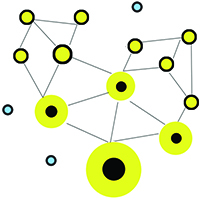Metropolitan Governance for Territorial Cohesion
Abstract
This paper proposes and defines new metropolitan governance strategies for territorial cohesion between inland and urban areas. Different reflections are here presented to comprehend how is it possible to implement cities’ ability to understand and manage metropolitan dynamics. In Europe, urbanisation and land abandonment is a widespread phenomenon compared to many other parts of the world. According to research carried out by the European Union it is estimated that four out of five European citizens will be living in urban areas abandoning villages and rural areas.
Many European metropolitan areas are character-rized by overpopulated centres, degraded suburbs and different abandoned or almost abandoned inland areas. These areas, if well connected among them and to the main metropolitan centre, can contribute to solving many urban challenges. There is the necessity to image metropolitan areas as a single entity to increase the cohesion of lands. The latent capital of inland areas can be considered as driving factor behind territorial cohesion and development. This paper analyses in deep the case of the Italian Metropolitan Cities proposing a new governance approach to increase the capacity of urban systems to adapt to natural and man-made changes, considering the hinterland as a strong point rather than a disadvantage.
Strategic and Spatial Plans drive the growth of metropolitan areas in a competitive space-economy and support sustainable development policy by ensuring a balance between urban areas with strong competitiveness and inland areas.
Downloads
References
AURAN Nantes Regional Planning Agency (2013). European Debate on Territorial Cohesion Contribution. Brussels, BE: European Union printing office.
Andersson M. (2012). Proceedings from: The World Bank's Sixth Urban Research and Knowledge Symposium, Washington, DC: World Bank printing office.
Benayas J. M. R., Martins A., Nicolau J. M., Schulz J. (2007). Abandonment of agricultural land: an overview of drivers and consequences. CAB Reviews: Perspectives in Agriculture, Veterinary Science, Nutrition and Natural Resources, 57, 1-14. doi:http://dx.doi.org/10.1079/PAVSNNR20072057
Di Figlia L. (2012). Proceedings from: The AESOP annual Congress Association of European Schools of Planning in Ankara, Porto, PR: AESOP publishing.
European Department for Spatial Planning and Territorial Development. (2011). Territorial Agenda 2020 - Towards an Inclusive, Smart and Sustainable Europe of Diverse Regions. Brussels, BE: European Union printing office.
Eurostat. (2016). Urban Europe Statistics on cities, towns and suburbs - Statistical books. Brussels, BE: European Union printing office.
Fratesi U., Perrucca G. (2014). Territorial Capital and the Effectiveness of Cohesion Policies: an Assessment for CEE Regions. Investigaciones Regionales, 29, 165-191. Available at http://www.aecr.org/images/ImatgesArticles/2014/10/08Fratesi.pdf
Koulouri M., Giourga C. (2007). Land abandonment and slope gradient as key factors of soil erosion in Mediterranean terraced lands. Elsevier, 69(3), 274–281. doi:http://dx.doi.org/10.1016/j.catena.2006.07.001.
Hollander K., Meijers E. (2012). EMI - European Metropolitan network Institute: Case study Milan Metropolitan Area. Brussels, BE: European Union printing office.
Otero I., Marull J., Tello E., G. L. Diana, Pons M., Coll F., and Boada M. (2015). Land abandonment, landscape, and biodiversity: questioning the restorative character of the forest transition in the Mediterranean. Ecology and Society, 20(2), 20-35 . doi:http://dx.doi.org/10.5751/ES-07378-200207.
Lasanta T., Arnáez J. et al. (2016). Space–time process and drivers of land abandonment in Europe. Elsevier, 149(3), 810-823. doi:http://dx.doi.org/10.1016/j.catena.2016.02.024.
Passarelli D., Foresta S., Fazia C. (2016). The role of transport system in the implementation of the strategy for inland areas. Elsevier Procedia - Social and Behavioral Sciences, 223, 520-527. doi:http://dx.doi.org/10.1016/j.sbspro.2016.05.322.
Pirlone F., Spadaro I., Candia S. (2016). Mobilità e sharing economy - Razionalizzazione e potenziamento della mobilità nelle aree interne in A new cycle of urban planning between tatic and strategy (30-35). Milano, IT: Planum publisher.
Pirlone F. (2016). I borghi antichi abbandonati: un patrimonio da riscoprire e mettere in sicurezza, Milano, IT: Franco Angeli.
Papa, R., Gargiulo, C., & Galderisi, A. (2013). Towards an urban planners’ perspective on Smart City. Tema. Journal Of Land Use, Mobility And Environment, 6(1), 5-17. doi:http://dx.doi.org/10.6092/1970-9870/1536.
Papa R., Gargiulo C., Battarra R. (2016). Città Metropolitane e Smart Governance. Iniziative di successo e nodi critici verso la Smart City. Tema. Journal Of Land Use, Mobility And Environment, 7 (25), 1-597. doi:http://dx.doi.org/10.6093/978-88-6887-005-8.

Copyright (c) 2017 Tema. Journal of Land Use, Mobility and Environment

This work is licensed under a Creative Commons Attribution 4.0 International License.
Authors who publish in this journal agree to the following:
1. Authors retain the rights to their work and give in to the journal the right of first publication of the work simultaneously licensed under a Creative Commons License - Attribution that allows others to share the work indicating the authorship and the initial publication in this journal.
2. Authors can adhere to other agreements of non-exclusive license for the distribution of the published version of the work (ex. To deposit it in an institutional repository or to publish it in a monography), provided to indicate that the document was first published in this journal.
3. Authors can distribute their work online (ex. In institutional repositories or in their website) prior to and during the submission process, as it can lead to productive exchanges and it can increase the quotations of the published work (See The Effect of Open Access)
